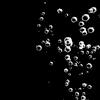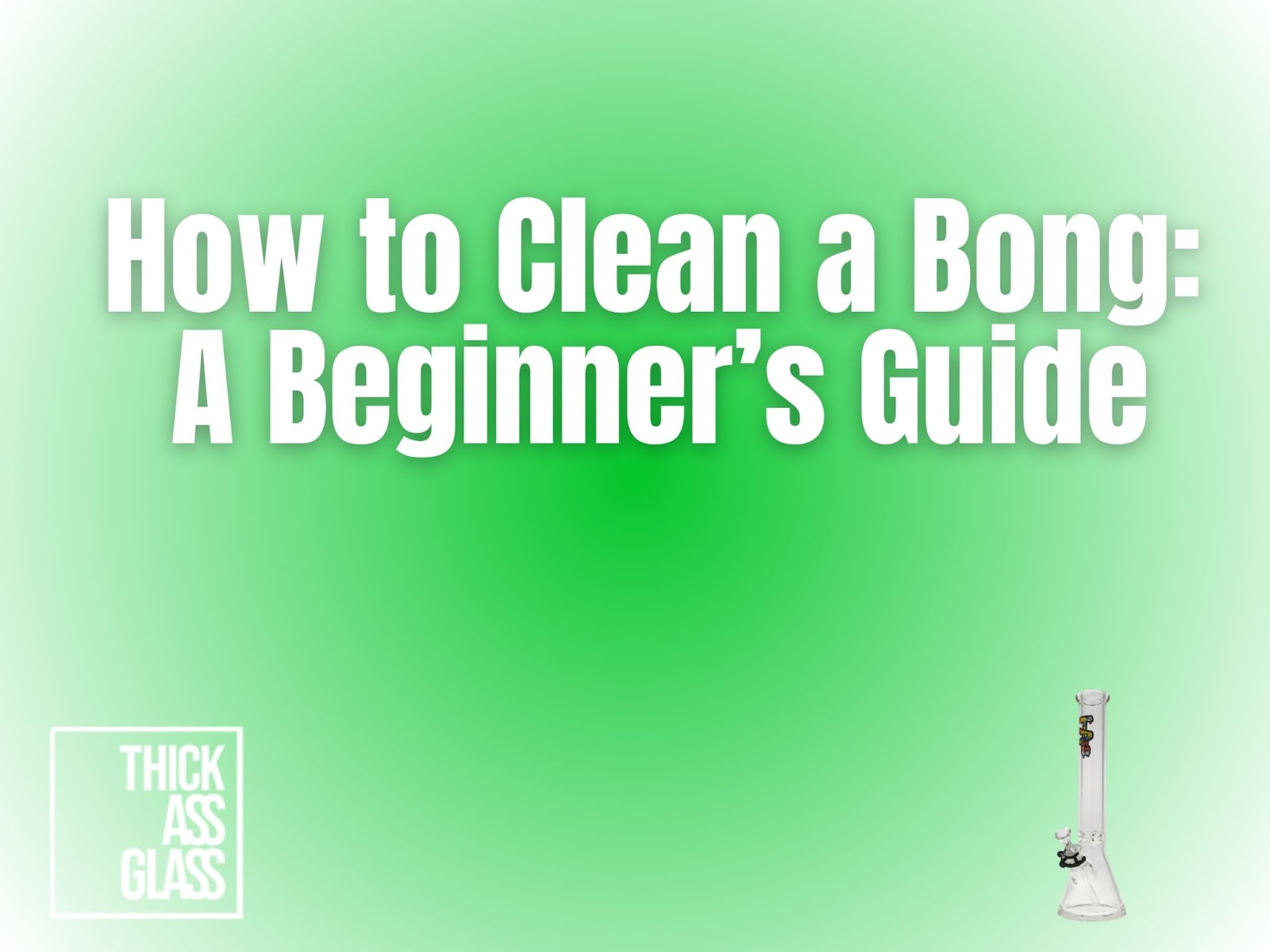You didn’t drop good money on a solid glass piece just to taste burnt tar and stare at brown water. A well-made bong should deliver clean airflow, smooth diffusion, and full flavor. But the second you let that thing go a few sessions without a rinse, it stops doing what it was built to do.
When your bong sits dirty, here’s what you’re really inhaling:
-
Bitter, ashy flavor that ruins even top-shelf flower
-
Clogged bowls and tight pulls that kill the airflow
-
Bacteria colonies and biofilm taking hold inside the water
-
Stuck joints, seized percs, and trapped gunk in every corner
-
Higher risk of cracking from thermal stress or poor handling during rushed cleaning
And no, thick glass doesn’t make you immune to any of it. At Thick Ass Glass, we engineer pieces for strength, airflow, and long-term function, but even the toughest 16mm base can’t prevent what happens when resin and bacteria build up over time.
This guide walks you through exactly why bongs get filthy, what cleaning agents actually break that stuff down, and how to clean every part of your piece without wrecking the glass or wasting your time.
We’ll also point out which TAG bongs are easier to clean and why they’re designed that way. If your bong’s tasting off or pulling harder than it used to, you’re overdue. Let’s fix that.
This Is Why Your Bong Turns Nasty So Fast
Even the most well-designed piece starts to underperform if you let buildup creep in. It doesn’t happen all at once. A few sessions here, a forgotten rinse there, and suddenly the airflow’s off and the flavor’s gone.
To keep your bong functioning like it should, it helps to understand where the mess actually starts, what causes it, and which parts need regular attention.
Resin + Ash = The Sticky Culprit
Combustion leaves behind more than smoke. Every hit deposits fine particles of ash and a sticky film of resin. These start to line the inside of your bong from the very first bowl. Thinner parts of the glass are especially prone to buildup because airflow is tighter, and that creates a natural trap.
Even with clean water, if resin is allowed to collect, it gums up your percs, narrows your draw, and dulls the flavor of your flower.
Stagnant Water Is a Biohazard
If the water in your bong smells off, it probably is. Left sitting for more than a day, that water becomes a breeding ground for bacteria. Mold spores, mildew, and even harmful microbes can start to multiply. And since smoke carries vapor with it, every pull brings those contaminants into your lungs.
Fresh water isn’t just about taste. It’s a basic hygiene practice that helps keep your session clean and your gear from developing that sour, musty smell.
Choke Points Trap the Worst Build-Up
Most of the mess doesn’t sit in plain sight. It collects in tight corners and recessed areas that don’t flush out with a quick rinse. These are the spots you need to clean with purpose:
-
Bowl and slide joint: where tar builds up fast and can lock your bowl in place
-
Downstem base: often clogs first and cuts off your airflow
-
Percolators: especially tree arms, honeycomb discs, and fritted plates that require soaking
-
Ice catchers: surprisingly common spots for grime and biofilm to form
Two TAG Bongs That Stay Cleaner, Longer
Some bongs just make cleaning easier.
-
TAG 12” Beaker, 44x4MM: The wide mouth and open design give you full access. Fewer percs mean fewer choke points to manage.
-
TAG 16” Straight Tube Bong: This model is all about straight lines, so it offers few spots where grime could collect. At the same time, it’s chamber is large enough for a huge hit
Break Down the Grime: The Best Bong Cleaning Agents
Cleaning a bong doesn’t require a shelf full of specialty products, but using the right cleaning agent for the job makes a big difference.
Whether you are doing a quick rinse or tackling weeks of buildup, the right choice depends on what type of residue you are dealing with, what your bong is made of, and how often you clean it. Each option below serves a purpose and can be used alone or in combination depending on the condition of your piece.
Hot Water
Start simple. Hot water works better than people give it credit for, especially when used right after a session. It loosens up tar and resin before it gets the chance to harden. Use the hottest tap water you can get, close to boiling but not actually boiling.
This is safe for thick borosilicate glass and helps prevent the need for more aggressive scrubbing later. As a daily maintenance step, it keeps lighter users from having to deep clean as often. For those with thick bases and wide chambers, hot water flushes help prep the surface for whatever cleaning agent you add.
Isopropyl Alcohol (91–99%)
This is the standard for good reason. Isopropyl alcohol dissolves resin, tar, oils, and all the sticky mess that builds up inside your bong. The higher the percentage, the better it works.
When paired with a coarse abrasive, alcohol becomes a fast and effective cleaning system that strips away buildup from even hard-to-reach spots. It is safe for quality borosilicate glass as long as you rinse thoroughly. Avoid using it on acrylic or silicone, since it can degrade those materials over time.
If your bong has been sitting dirty for a while, you can improve the effect by slightly warming the sealed bottle in a bowl of hot water before use. The added heat softens the resin and speeds up the chemical action without adding risk to your glass.

White Vinegar
For those avoiding alcohol or dealing with hard water stains, white vinegar is a solid alternative. It is acidic enough to dissolve mineral deposits, which often appear as cloudy rings or streaks in glass. Vinegar works best when heated and used as a soak.
This approach is slower, but ideal for users who clean more frequently or who live in areas with high mineral content in their water. While it does not break down resin as aggressively as alcohol, it is still helpful for keeping your glass clear and smooth between deeper cleanings.
Acetone
Acetone is the heavy-duty option. It breaks down stubborn, caked-on grime quickly and completely, but it demands more care. Use it only in a space with good airflow and always follow up with a long rinse.
Acetone is best suited for thick-walled glass like what we produce at TAG, but should never be used on painted or custom-decorated pieces. It strips everything, including finishes.
For older bongs that have not seen a cleaning in far too long, acetone can bring them back to life with minimal effort, but you have to be precise and patient during the rinse to make sure it is fully cleared before use.
Why Abrasives Are the Secret Weapon for Deep Cleaning
Cleaning agents dissolve residue, but it is the physical scrubbing action that actually breaks it loose. That is where abrasives come in. They add friction inside your piece, making each shake more effective. When combined with a proper solvent, they reach into every curve and corner of your bong, pulling away grime without damaging the glass. This is especially helpful in designs with narrow airpaths or hidden recesses that are hard to reach with tools.
Salt Is the Top Choice
Coarse salt works because it does not dissolve instantly. That means it stays active during the entire cleaning process, hitting every angle as you shake your bong. It also rinses out cleanly with hot water and will not scratch borosilicate glass, even under pressure.
It is widely available and cost-effective, which makes it the go-to option for most people who clean regularly.

Salt also pairs perfectly with TAG’s design philosophy. Our CAD-engineered downstems and precision-cut percs are made to reduce resistance and keep flow paths accessible. Salt agitation complements that by knocking loose residue without clogging. The result is a faster, more thorough clean.
Other Abrasive Options
If you are short on salt or just prefer alternatives, there are other materials that offer similar scrubbing power:
-
Dry rice works well in longer tubes where it can travel the full length of the piece
-
Baking soda is a gentle option that also neutralizes odors
-
Activated charcoal powder has fine texture and odor-absorbing properties, making it useful for freshening the glass during a clean
Step-by-Step Bong Cleaning Instructions
You do not need complicated tools or expensive supplies to get your bong looking and functioning like new. What you do need is the right process. A proper clean restores airflow, brings back flavor, and helps your piece last longer.
Whether you are using alcohol and salt or one of the alternative methods, these steps will guide you through a complete clean that covers every part of your bong.
-
Disassemble Everything: Start by taking your piece apart. Remove the bowl, downstem, ash catcher, and any other modular parts. Cleaning is more effective when every component is cleaned individually. This also prevents buildup in tight connection points.
-
Rinse with Hot Water: Use near-boiling tap water to flush out loose debris. This also warms the glass, softens residue, and prepares the surface for your cleaning agent. For thick glass like what we produce at TAG, this step is safe and highly effective.
-
Fill with Cleaning Agent and Abrasive: Add your cleaning solution to each part. Use alcohol and salt if you are going with the most efficient option. For bowls and downstems, seal them inside plastic bags or small containers with the same mix. This creates a closed system that makes shaking easier.
-
Seal and Shake: Use cleaning plugs or your hands to cover all openings. Shake firmly for at least two minutes. This distributes the abrasive and ensures it scrubs through the entire chamber. Consistent movement here does more than soaking ever will.
-
Soak Stubborn Spots: Let your parts sit in their solution for up to an hour. This helps break down thicker buildup in percolators or tight passageways. For multi-perc pieces, consider longer soak times.
-
Rinse Until Odor-Free: Flush with clean hot water until there is no smell of alcohol or vinegar left behind. This step is key to maintaining flavor during your next session.
-
Let Everything Dry: Air dry your bong upside down or use clean towels to speed things up. Make sure no moisture remains before you reassemble to avoid odor or mold.
Perc-Cleaning 101: Take Extra Care
Percolators are what take a solid bong and make it a true performer. More chambers and more diffusion mean smoother hits, cooler smoke, and a better session overall. But with all that extra glasswork comes added maintenance.
Every slit, arm, and disc inside a perc is another surface where resin can settle. Cleaning these areas properly keeps airflow strong and flavor consistent.
Cleaning Hard-to-Reach Percs
Start with a soak using isopropyl alcohol and coarse salt. This softens and loosens buildup before you even begin shaking. After soaking, use a straw brush or soft pipe cleaner to reach inside the chambers. These tools can navigate through perc arms without damaging the glass.
For pieces with tree percs, try inverting the bong during rinses. Letting gravity help the cleaning solution pass through each arm makes the process more thorough. Once you finish shaking and brushing, rinse multiple times with hot water.
Residual salt and resin need to be completely removed for the piece to function like it should.
If your percs still give off a strange flavor even after cleaning, it usually means there is lingering moisture or alcohol trapped inside. Let the entire piece dry out completely before using it again. Clear borosilicate makes this easier to check.
Two TAG Perc Bongs Worth the Effort
-
TAG 22" Double 12-Arm Tree Perc delivers dense filtration with impressive smoothness. The quality of the cut and symmetry in the tree arms makes it easier to clean than expected.
-
TAG 18.75" Triple Fritted Disc offers intense diffusion and a striking visual water cycle. Built thick and engineered for airflow, it handles deeper cleaning sessions with ease.
Keeping It Clean And Smelling Nice
Clean glass keeps your sessions tasting fresh and your airflow consistent. The trick is to make maintenance part of the routine rather than a project you avoid. With a few simple habits and the right timing, you can keep your bong in top shape without much effort.
How Often Should You Clean?
Your cleaning schedule depends on how often you use your piece. Consistent care prevents buildup and keeps everything running smoothly.
-
Heavy users benefit from a quick hot water rinse after each session and a deep clean once or twice a week
-
Light users can usually go about seven to ten uses before doing a full clean, as long as the water is swapped out regularly
-
Anytime the draw feels tight or the smell changes, it is time for another round of cleaning
Smell and airflow are the best signs that something needs attention. If your bong tastes off or feels sluggish, a simple rinse can often bring it back.
Habits That Help You Stay Ahead of the Grime
You can avoid most deep cleans with a few small steps after each use. These habits help reduce residue and odor before they have a chance to settle.
-
Use distilled water instead of tap to cut down on mineral stains and cloudy buildup
-
Empty and rinse your piece after every session to keep residue from drying in place
-
Add an ash catcher to intercept debris before it reaches the chamber
-
Store your bong upright in a cool, dry area to let it breathe between uses
-
Avoid overfilling, especially on percolator designs, since water can splash into hard-to-clean spots
Clean Glass Hits Better. Period.
A well-designed bong should move air smoothly, clear instantly, and stay consistent from the first pull to the last. That only happens when the pathways inside it are clean. Resin buildup throws everything off. It changes how your piece drains, how the chamber fills, and how it clears.
We design every TAG bong with cleaning in mind. Wide openings, removable downstems, and precision-cut percs make maintenance simple.
If you want a piece that performs like it should and keeps doing it for the long haul, start with better glass.
👉 Browse TAG’s full collection of durable, easy-to-clean bongs



